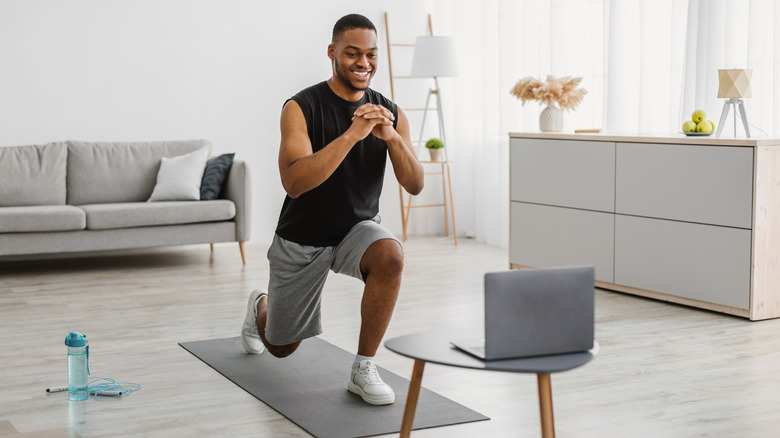If You Can't Do A Lunge, This Is What Your Body Is Trying To Tell You
A popular strength training exercise with various variations is the lunge. Forward, side, or back lunges...You name the type of lunge and a muscle burn is quick to follow, sculpting, toning, and strengthening the leg muscles. In fact, they target various leg muscle groups aiding in balance, coordination, weight loss, and core stability (via Healthline). There are so many benefits to lunging, that you'll want to incorporate them into your workout routine. But some bodies have difficulty getting into any lunge position at all.
Forward lunges especially seem to cause grief for many of us. Three of the biggest complaints revolve around instability, knee pain, and the inability to lunge low (per Livestrong). In regards to instability, certified strength and conditioning specialist Lance Goyke told Livestrong,"The idea behind the lunge is to train your balance, so a little wobbling is good." While the instability and possible shaking may feel uneasy, it's actually training your balance and strengthening your eccentric muscles as you lower down (via Popsugar).
However, knee pain is often associated with weak glutes, points out Livestrong. When the glutes are weak, it causes a ripple effect down the leg chain, moving the knee and hip joints inward (via Livestrong). Whereas the inability to lunge low is signaling a lack of mobility and strength (via Livestrong).
Three ways to help your body lunge better
Luckily, if you can't lunge and are experiencing any of the following problems above there are some common fixes you can try. When it comes to instability, try to widen your lunge stance (per Livestrong). "A wider stance will provide you with greater stability through the knee and ankle and help with balance," certified personal trainer George Branford tells Livestrong. Naturally, the lowering down motion of lunging produces more instability, because it requires more control. While it may seem counterintuitive, try lunging more often since it builds up strength in the leg muscles (via Popsugar).
However, if range of motion is the reason you can't lunge, Livestrong suggests focusing on mobility exercises or trying other lunge variations until you can lunge deeper. Try side lunges that target the inner thighs, or low lunges, with the front leg perpendicular to the ground and the back leg straight (per VeryWell Fit). These each target and train leg muscles in different ways, so you can lunge with better depth.
Lastly, if knee pain is the issue, check your alignment because you may be rotating the knee (via VeryWell Fit). Alternatively, you could have weak glutes, so toss in resistance bands with bridges (per Livestrong).


